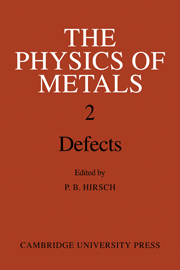4 - Solution and precipitation hardening
Published online by Cambridge University Press: 04 August 2010
Summary
INTRODUCTION
This article is concerned with the hardening of solids, mainly metals, by various arrays of solute atoms. Random solid solutions, coherent and incoherent precipitates are considered. In addition, some attention is given to alloys containing long-range order, which have recently been studied in detail. The general theory of dislocation locking by atmospheres of solute atoms is omitted, but some recent developments are described. A study of the effect of the displacement of atoms of the matrix to produce vacant lattice sites or interstitial ions should logically form part of the present work. Largely on account of its importance in nuclear reactor technology, a great deal is known about this topic, and the reader is referred to the available books and conference reports (Dienes and Vineyard, 1957; IAEA, 1962–3; Strumane et al, 1964; Chadderton, 1965).
TYPES OF LATTICE DEFECT
The presence of any imperfections in the lattice hinders the motion of dislocations through a crystal. Intrinsic point defects, vacant lattice sites and interstitial ions, are inevitably present in thermal equilibrium (see chapter 1). They may aggregate to form divacancies, larger aggregates, or possibly large spongy regions or voids. In face-centred cubic metals, the concentration of vacancies near the melting point may reach almost 1 in 103 (Simmons and Balluffi, 1960a); irradiation introduces vacancies and interstitial ions in large and essentially equal numbers. In solid solutions, solute atoms may either substitute for atoms of the matrix or lie in interstitial positions.
- Type
- Chapter
- Information
- The Physics of Metals , pp. 152 - 188Publisher: Cambridge University PressPrint publication year: 1976
- 10
- Cited by



